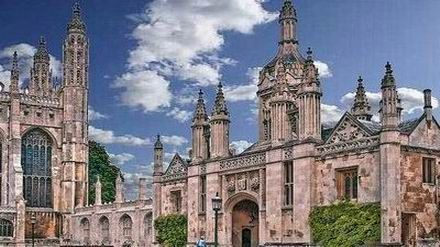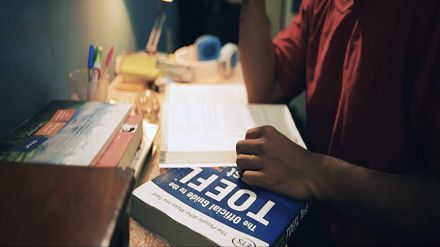10月最新的托福考试将会在23日举办,你的托福考试准备好了吗?来看看真题的预测吧。下面是出国留学网小编为大家整理的2021年10月23日托福听力考试真题预测,仅供参考。
2021年10月23日托福听力考试真题预测
1. What is the lecture mainly about?
(A) Ways to generate heat for nuclear fusion
(B) Differences between nuclear fission and nuclear fusion
(C) A controversial theory regarding how to generate nuclear fusion
(D) The possibility of establishing sustained nuclear fusion
2. According to the students, what are three advantages of nuclear fusion over nuclear fission
Click on 3 answers.
(A) Nuclear fusion can use a fuel that is more easily obtained.
(B) Nuclear fusion can be achieved at lower temperatures.
(C) Nuclear fusion produces more energy.
(D) Nuclear fusion does not produce hazardous by-products.
(E) Nuclear fusion does not require as many natural resources.
3. Why does the professor mention isotopes of hydrogen?
(A) To correct a student's comment about how fusion takes place in stars
(B) To help answer a student's question about temperature requirements for fusion reactors
(C) To explain what happens to hydrogen atoms during fusion reactions
(D) To justify the need for superconducting magnets in nuclear fusion reactors
4. According to the professor, how will the ITER reactor differ from earlier experimental fusion reactors?
Click on 2 answers.
(A) It will be transportable to different locations.
(B) It will sustain nuclear reactions through heat that it generates on its own.
(C) It will heat the fuel mixture to a higher temperature.
(D) It will confine the plasma in a more energy-efficient way.
5. What does the professor say about the international effort to develop ITER?
(A) The participation of many countries may cause ITER to be delayed even more.
(B) The research orientation of ITER has encouraged international collaboration.
(C) ITER will make use of equipment made in many different countries.
(D) The lack of international cooperation on earlier fusion projects has hurt ITER.
6. What does the professor imply when he says this:
(A) He prefers to work on projects with more immediate results.
(B) He believes that research in the physical sciences requires strict time lines.
(C) He thinks it will take less time to develop ITER than most researchers expect.
(D) He is more skeptical about the future of nuclear fusion than most researchers are.
Script:
Narrator:Listen to a discussion in an environmental policy class
Professor:So, today we’re going to wind up our discussion of alternative energy sources and we’re going to talk about one that often gets overlooked. That source is nuclear fusion as opposed to nuclear fission, which is already discussed. In nuclear fission, the centers of atoms, the nuclei, are broken up. This is the reaction today that drives today’s nuclear-powered stadiums. Nuclear fusion, on the other hand, is pretty much the opposite. It occurs when two atoms collide and then nuclei combine, or fuse, to form a heavier nucleus. This is the reaction that powers the Sun, all stars. So, who can tell me what makes fusion more attractive than fission as an energy source. Julie?
Julie:Well, it releases more energy, for one thing.
Professor:Yeah, a lot more energy than fission.
Julie:Oh also, it can use hydrogen as a fuel source. And hydrogen is abundant and easily available in water. Fission uses uranium, which is way more difficult to find.
Male:Plus, fission is more dangerous. With fusion, you wouldn’t have to worry about radioactive waste, right?
Professor: Another good point.
Male:But still, I remember from my physics class, to fuse the nuclei of two hydrogen atoms require temperature found similar to the sun, like over 100 million degrees Kelvin. How can we possibly recreate those temperatures here on Earth?
Professor:Well, we can’t yet. Not sustainably. But maybe we don’t need to. See, right many countries around the globe are cooperating to realize the potential of nuclear fusion. And the project they’re putting the most resources into is called ITER. ITER stands for International Thermonuclear Experimental Reactor, a large fusion reactor that’s being built in southern France. It’s designed to create the first sustained nuclear fusion reaction, meaning the energy it will release is greater than the energy we’ll use to start it up. And I’ll get back to this point in a moment. But let’s back up.
You asked about how we generate the tremendous temperature required for fusion. Well, that’s not really the problem. There are heavier isotopes of hydrogen, deuterium and tritium that will undergo fusion at lower temperatures than regular hydrogen. And when we tend to do deuterium, tritium mixtures that much, around 40 million Kelvins, it generates what’s called a plasma, which is a cloud of ionized gas.
So what is the problem? Well, it’s twofold. First, the plasma, this cloud of plasma, is way too hot for any solid container to hold. Fortunately, high temperature plasma conducts electricity, which means we can use an electromagnetic force to hold the plasma in place to confine it. Unfortunately, that requires a lot of energy, more energy than we’d ever be able to get from the resulting fusion reaction. And this brings us back to the point I mentioned before. Creating a sustained fusion reaction, because up to now experimental fusion reactors have never been able to achieve this, this break-even point, the point where the energy output is as great as the input for more than a fraction of a second.
How will the ITER project overcome this? First, by creating a larger plasma. Twice as large as any previous generated. The advantage of this is that once the initial fusion reaction occurs, the larger plasma will generate enough energy to keep itself hot, to keep the fusion reaction going. And second, ITER will use super-conducting magnets to form the magnetic field, magnets that consume less electrical power than those used in previous attempts. So, less energy goes in. More energy comes out. Theoretically, it should do the trick.
Now, keep in mind, the ITER reactor has been in the works for about twenty years and it will probably take another decade to build. And even then, of course it will be used for research purposes. Commercial fusion won’t be feasible for at least another twenty years after ITER is built. So that’s a long timeline, right? Not something I’d be comfortable in my own work. I need shorter term goals to motivate me. But for those who can handle it, well, it means this project is not about short term economic competition or gains. So in a way, it’s easier to get countries to work together on it. If we cooperate, we’ll get there sooner because we know how much difficult it is to do it alone.
推荐阅读:

